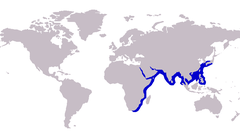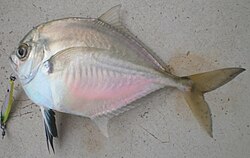fr
noms dans le fil d’Ariane


Atropus atropos és un peix teleosti de la família dels caràngids i de l'ordre dels perciformes.[2][3]
Atropus atropos és l'única espècie del gènere Atropus.[4]
Pot arribar als 26,5 cm de llargària total.[5]
Es troba a les costes de l'Oceà Índic i a l'oest del Pacífic.[5]
The cleftbelly trevally (Atropus atropos), also known as the cleftbelly kingfish, Kuweh trevally or thin crevalle, is a species of tropical marine fish of the jack family, Carangidae. The species inhabits coastal waters throughout the Indo-West Pacific region from South Africa in the west to Japan in the east, often found near the water's surface. The cleftbelly trevally is the only member of the genus Atropus and is distinguished by a number of anatomical characteristics, with a deep median groove in the belly giving the species its common name. It is not a large fish, growing to a maximum recorded length of 26.5 cm. Cleftbelly trevally are predatory fish, taking a variety of small crustaceans and fish. The species is of minor importance to fisheries throughout its range.
The cleftbelly trevally is the only species in the genus Atropus, which is one of 31 genera in the jack family, Carangidae. The Carangidae are part of the order Carangiformes.[2]
The species was first scientifically described under the name of Brama atropos by German ichthyologists Marcus Elieser Bloch and Johann Gottlob Schneider in the massive 1801 volume of Systema Ichthyologiae iconibus cx illustratum, a document which is the taxonomic authority for many species.[3] Bloch and Schneider placed the species in the genus Brama, within the pomfret family. The generic position of the species was revised twice, once being placed in the jack genus, Caranx, and finally into Atropus. The genus Atropus had been informally created by Georges Cuvier in 1817 as "Les Atropus", and was formally Latinized by Lorenz Oken, thus making him the author of the genus.[4] A. atropos is the type species of the genus by monotypy. The type specimen was taken from the waters of Puducherry, in India.
The fact that the generic and specific names differ by a single letter has also led to the misspelling of the species as Atropus atropus in some publications.[4] The species is most commonly referred to in English as the cleftbelly trevally, with other names including cleftbelly kingfish, Kuweh trevally and thin crevalle.[3] It is also occasionally called the 'blackfin jack', but should not be confused with Hemicaranx zelotes, also known by that name.
The cleftbelly trevally has a body shape similar in many ways to a number of the larger jacks, with a strongly compressed body almost ovate in shape.[5] The dorsal profile of the head is straight and steep from the tip of the upper jaw to above the eye where the profile becomes convex. The eye lacks an adipose eyelid, and the upper jaw has a narrow band of small teeth, while the lower jaw has two or three rows of small teeth which narrow to one row on the sides of the jaw.[5] The ventral profile is concave upwards, with a major distinguishing feature of the species being a deep median groove along the belly, into which the large pelvic fins fold, also encompassing the first two anal fin spines and anus. The entire chest from underneath the pectoral fins to the base of the pelvic fins is scaleless.[4] There are two separate dorsal fins, the first with eight spines and the second with a single spine followed by 19 to 22 soft rays.[6] The anal fin has two detached spines before the major part of the anal fin, which consists of one spine and 17 or 18 soft rays. The pectoral and pelvic fins are both quite long, with the latter extending almost to the anal fin origin. The lateral line has a moderately strong arch anteriorally which intersects the straight section underneath the fifth to seventh dorsal rays. The straight part of the lateral line has 31–37 scutes.[6]
There are 24 vertebrae and 29 to 34 total gill rakers.[5] The species is known to reach 26.5 cm in length, although often encountered below 20 cm.[3]
The cleftbelly trevally is a bluish green on the upper body which fades to silver on the underside of the fish. The membranes of the large pelvic fin are a distinctive black, while the remaining fins are a pale white colour. Juveniles have indistinct dark bands across their bodies, with a black spot becoming more prominent in adults.[6]
The species show sexual dimorphism in their dorsal fins, with mature males having between 6 and 12 elongated soft rays, strung out into filaments of varying lengths. The anal fin is also has five similar extensions of the soft rays. Females do not show this elongation.[7]
The cleftbelly trevally inhabits the tropical and subtropical waters of the Indo-West Pacific region. Its range extends from South Africa[8] along the east African coast[9] including the Persian Gulf, east to India, Southeast Asia, the Philippines, Taiwan and southern Japan.[5] Some sources state the Persian Gulf as the westernmost point of the species range, but specimens sent to Henry Fowler from South and eastern Africa in the 1930s show this to be incorrect.[8][9]
The species inhabit shallow coastal waters, where they swim close to the surface. There has been a report of the species living in areas near estuaries which empty large flows of fresh water into these areas, indicating the species may be able to live in estuarine environments.[10]
The cleftbelly trevally is a predatory species, preying on small crustaceans including shrimps, copepods and decapods, as well as small fish.[11] Reproduction in the species has not been extensively studied, although early growth has been described in a 1984 article. The study was located in India, and showed the fish grows 12.4 cm in its first year of life, growing slower in its second and third years, adding 7.35 cm and 3.5 cm to its total length, respectively, in these years.[12] The species reaches sexual maturity at 21 cm, in the second or third year of its life.[13]
The species is of minor importance to fisheries throughout its range, taken mainly by trawls, traps and by various hook-and-line methods.[5]
The cleftbelly trevally (Atropus atropos), also known as the cleftbelly kingfish, Kuweh trevally or thin crevalle, is a species of tropical marine fish of the jack family, Carangidae. The species inhabits coastal waters throughout the Indo-West Pacific region from South Africa in the west to Japan in the east, often found near the water's surface. The cleftbelly trevally is the only member of the genus Atropus and is distinguished by a number of anatomical characteristics, with a deep median groove in the belly giving the species its common name. It is not a large fish, growing to a maximum recorded length of 26.5 cm. Cleftbelly trevally are predatory fish, taking a variety of small crustaceans and fish. The species is of minor importance to fisheries throughout its range.
Atropus atropos es una especie de peces de la familia Carangidae en el orden de los Perciformes.
Los machos pueden llegar alcanzar los 26,5 cm de longitud total.[1]
Se encuentra en las costas del Océano Índico y al oeste del Pacífico.
Atropus atropos es una especie de peces de la familia Carangidae en el orden de los Perciformes.
Atropus atropos Atropus generoko animalia da. Arrainen barruko Carangidae familian sailkatzen da.
Atropus atropos Atropus generoko animalia da. Arrainen barruko Carangidae familian sailkatzen da.
Atropus atropos, unica specie del genere Atropus, è un pesce d'acqua salata appartenente alla famiglia Carangidae.
Si nutre di piccoli pesci e crostacei (gamberetti, copepodi e decapodi).
Atropus atropos, unica specie del genere Atropus, è un pesce d'acqua salata appartenente alla famiglia Carangidae.
Atropas (lot. Atropus atropos, angl. Cleftbelly trevally) – stauridinių (Carangidae) šeimos žuvis, vienintelė rūšis atropų (Atropus) gentyje.
Kūnas 26,5 cm ilgio, suplotas. Viršutinis žandikaulis turi siaurą mažų dantelių eilę, apatinis – tris. Grobuoniška. Minta smulkiais vėžiagyviais ir kitomis mažesnėmis žuvimis. Paplitęs Indijos vandenyno ir Ramiojo vandenyno atogrąžų klimato vandenyse, nuo Pietų Afrikos iki Japonijos rytinės dalies.
Atropus atropos is een straalvinnige vissensoort uit de familie van horsmakrelen (Carangidae).[1] De wetenschappelijke naam van de soort is voor het eerst geldig gepubliceerd in 1801 door Bloch & Schneider.
Bronnen, noten en/of referentiesAtropus indyjski (Atropus atropos) - gatunek ryby z rodziny ostrobokowatych.
Ocean Indyjski oraz zach. Pacyfik. Na płn. sięga po Prefekturę Mie w Japonii.
Zazwyczaj spotykany w płytkich, przybrzeżnych wodach.
Osiąga max. 26,5 cm długości. Ciało krótkie, wysokie, bocznie spłaszczone. przednia część grzbietu wyraźnie wypukła. Otwór gębowy przedni. Wzdłuż linii bocznej występują tarczki. Na pierwszym łuku skrzelowym 29 - 32 wyrostki filtracyjne, 8 - 9 na górnej i 21 - 23 na dolnej części. W płetwie grzbietowej 9 twardych i 21 - 22 miękkie promienie, w płetwie odbytowej 3 twarde i 17 - 18 miękkich promieni. Płetwy brzuszne, umiejscowione przed początkiem płetwy grzbietowej, są charakterystycznie wydłużone, mogą być chowane do podłużnego rowka na brzuchu. U dorosłych samców środkowe miękkie promienie płetwy grzbietowej i odbytowej wydłużone.
Ubarwienie srebrzyste. Płetwy brzuszne czarne.
Zjada głównie krewetki, widłonogi, dziesięcionogi i małe ryby.
Nie ma większego znaczenia.
Atropus atropos. (ang.) w: Froese, R. & D. Pauly. FishBase. World Wide Web electronic publication. www.fishbase.org [dostęp 6 maja 2010]
Atropus indyjski (Atropus atropos) - gatunek ryby z rodziny ostrobokowatych.
Cá bao áo[1] (tên khoa học Atropus atropos) là một loài cá biển trong họ Carangidae.
Cá bao áo (tên khoa học Atropus atropos) là một loài cá biển trong họ Carangidae.

溝鰺(学名:Atropus atropus),俗名為銅鏡、女儿鲳、黑鳍鲳、腹沟鲹,為輻鰭魚綱鱸形目鱸亞目鰺科的其中一個種。
本魚分布於印度西太平洋區,包括波斯灣、馬爾地夫、斯里蘭卡、印度、安達曼海、日本、中國沿海、台灣、菲律賓、越南、泰國、馬來西亞、印尼、澳洲、新幾內亞海岸等海域。
水深5至35公尺。
本魚腹面中央現有一縱溝可收藏腹鰭、臀鰭、肛門孔。鱗片小,附著牢固,但退鮮時易脫落。第一背鰭有硬棘7至8枚,硬棘間有鰭膜,其色透明。第二背鰭及臀鰭前6軟條只稍有延長,最長的軟條只有最短軟條的1倍左右。第二背鰭有軟條21至22枚;臀鰭有硬棘1枚、軟條17至18枚。側線稜鱗數目在30至35枚左右。體長可達35公分。
本魚屬於中層洄游性魚類,約在二月時產卵,產卵前肉多脂肪而美味,卵巢飽滿後,體脂肪漸薄。常成群在海底沙堆上,用腹部左右搖擺來翻動沙堆,藏匿其中的小生物受驚嚇而逃出時,則立即追上捕食。為避免柔軟的腹鰭、臀鰭受傷,故藏在腹溝中。
 分類 界 : 動物界 Animalia 門 : 脊索動物門 Chordata 亜門 : 脊椎動物亜門 Vertebrata 綱 : 条鰭綱 Actinopterygii 目 : スズキ目 Perciformes 亜目 : スズキ亜目 Percoidei 科 : アジ科 Carangidae 属 : クボアジ属 Atropus
分類 界 : 動物界 Animalia 門 : 脊索動物門 Chordata 亜門 : 脊椎動物亜門 Vertebrata 綱 : 条鰭綱 Actinopterygii 目 : スズキ目 Perciformes 亜目 : スズキ亜目 Percoidei 科 : アジ科 Carangidae 属 : クボアジ属 Atropus
クボアジ(学名:Atropus atropos)は、アジ科に属し熱帯の海に生息する魚類である。本種は西は南アフリカ、東は日本までの、インド洋、西太平洋の沿岸域に広く生息し、しばしば表層近くでみられる。クボアジはクボアジ属を構成する唯一の種であり、腹部に溝があることなど、いくつかの形態的特徴から他属の魚類と区別が出来る。比較的小型の種であり、記録されている最大体長は26.5cmである。肉食魚で、様々な種類の小型の甲殻類や魚類を捕食する。生息域のほとんどにおいて、漁業においてそれほど重要な種ではない。
クボアジはスズキ目アジ科に属する31属のひとつ、クボアジ属を構成する唯一の種である[1]。
本種はBrama atroposという学名で、ドイツの博物学者、マルクス・エリエゼル・ブロッホとヨハン・ゴットロープ・シュナイダーにより1801年に『110の画像付分類魚類学』(Systema Ichthyologiae iconibus cx illustratum)の中ではじめて記載された[2]。ブロッホとシュナイダーは本種をシマガツオ科のシマガツオ属(Brama)に分類した。以降本種の分類は2度見直されており、はじめギンガメアジ属(Caranx)に、そして最終的にはクボアジ属(Atropus)に移されている。クボアジ属は1817年にキュヴィエによって"Les Atropus"としてフランス語で非公式に創設されたが、その後ローレンツ・オーケンが"Atropus"とラテン語化し、正式なクボアジ属の命名者はオーケンとなっている。本種はクボアジ属のタイプ種(単型)であり、本種のタイプ標本はインドのポンディシェリから得られたものである[3]。
属名と種小名が一字違いであるため、本種の学名をAtropus atropusと誤記している文献もみられる[3]。
クボアジの体型は他のアジ科魚類と似て、きわめて側偏した楕円形である[4]。背部の、頭部上顎の先から眼の上部にかけては、勾配の急な直線状になっている。眼に脂瞼(英語版)(不透明な瞼状の部分)は発達しない。上顎には小さい歯からなる歯列がある。下顎には小さい歯からなる歯列が2列から3列あり顎の端部ではそれらは1列に合流する[4]。腹部には大きな腹鰭を収容できる深い溝がある。溝の中には臀鰭(尻びれ)の第一、第二棘条と、肛門も存在している。胸鰭下部から腹鰭基部までの胸部には鱗がない[3]。背鰭はふたつに分離しており、第一背鰭には8本の棘条が、第二背鰭には1本の棘条とそれにつづく19本から22本の軟条が存在する[5]。臀鰭には、前方に分離した2本の棘条からなる部分と、1本の棘条と17本か18本の軟条からなる部分がある。胸鰭と腹鰭はどちらもきわめて長く、腹鰭はほぼ臀鰭の始点まで伸長する。側線は体の前方で湾曲する。側線の曲線部と直線部の境界は背鰭の第5から第7軟条の位置である。側線の直線部には31枚から37枚の稜鱗(英語版)(アジ亜科に独特の鱗)が存在する[5]。椎骨の数は24で、鰓篩の数は29から34である。[4]。最大で全長26.5cmに達することが記録されているが、通常みられるのは全長20cm以下の個体である[2]。
体色は、背部は青みを帯びた緑色で、腹部にかけて銀色になる。腹鰭の膜は明瞭な黒色で、他の鰭は白色である。未成魚には不明瞭な黒い帯が体側に入り、成長につれて黒い斑がみられることもある[5]。
本種は鰭について性的二型を示す。成熟した雄は腹鰭の軟条のうち6本から12本が伸長して様々な長さのフィラメント状になるほか、臀鰭の5本の軟条も同様に伸長する。雌においてはこの伸長はみられない[6]。
クボアジはインド洋、西太平洋の熱帯、亜熱帯域に生息する。本種の生息域は南アフリカ[7]からアフリカ東海岸[8]に沿って広がり、ペルシャ湾を含みながら、東はインド、東南アジア、フィリピン、台湾、日本へと広がる[4]。いくつかの文献においては分布の西端はペルシャ湾であるとされるが、ヘンリー・W・ファウラー(英語版)のもとに1930年代に南アフリカとアフリカ東部から標本が送られていることから、そのような記述は誤っているものとみられる[7][8]。
日本においては稀種であるが、三重県[9]や静岡県浜名湖[10]などから記録がある。
本種は浅い沿岸海域に生息し、表層近くを泳ぐ。また、淡水性の川も流れ込むエスチュアリーにも生息することが報告されている[11]。
クボアジは肉食魚で、エビやカイアシ類を含む小型の甲殻類や、小魚を捕食する[9]。繁殖については詳しい研究はなされていないものの、インドにおいて孵化直後からの成長について研究がなされている。その研究によると、孵化後はじめの1年間で本種は体長12.4cmまで成長し、その後成長は遅くなり、2年目までには体長19.75cm、3年目までには体長23.25cmに成長したという[12]。本種は孵化後2年から3年、体長21cmほどで性的成熟に達する[13]。
本種は生息域のほぼ全域において漁業においてそれほど重要な種ではないが、トロール漁などによって混獲されることがあり、鮮魚や干物として販売される[4]。
クボアジ(学名:Atropus atropos)は、アジ科に属し熱帯の海に生息する魚類である。本種は西は南アフリカ、東は日本までの、インド洋、西太平洋の沿岸域に広く生息し、しばしば表層近くでみられる。クボアジはクボアジ属を構成する唯一の種であり、腹部に溝があることなど、いくつかの形態的特徴から他属の魚類と区別が出来る。比較的小型の種であり、記録されている最大体長は26.5cmである。肉食魚で、様々な種類の小型の甲殻類や魚類を捕食する。生息域のほとんどにおいて、漁業においてそれほど重要な種ではない。